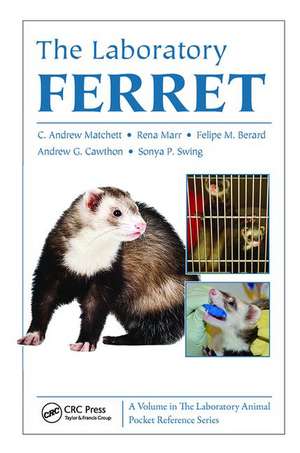The Laboratory Ferret: Laboratory Animal Pocket Reference
Autor C. Andrew Matchetten Limba Engleză Hardback – 10 noi 2017
Din seria Laboratory Animal Pocket Reference
- 8%
 Preț: 419.24 lei
Preț: 419.24 lei - 8%
 Preț: 390.57 lei
Preț: 390.57 lei - 8%
 Preț: 427.96 lei
Preț: 427.96 lei - 8%
 Preț: 402.17 lei
Preț: 402.17 lei - 15%
 Preț: 453.68 lei
Preț: 453.68 lei - 25%
 Preț: 337.74 lei
Preț: 337.74 lei - 23%
 Preț: 338.93 lei
Preț: 338.93 lei - 23%
 Preț: 339.35 lei
Preț: 339.35 lei - 23%
 Preț: 338.05 lei
Preț: 338.05 lei - 22%
 Preț: 358.88 lei
Preț: 358.88 lei - 22%
 Preț: 333.29 lei
Preț: 333.29 lei - 22%
 Preț: 328.39 lei
Preț: 328.39 lei - 23%
 Preț: 338.93 lei
Preț: 338.93 lei - 25%
 Preț: 1022.76 lei
Preț: 1022.76 lei - 26%
 Preț: 934.93 lei
Preț: 934.93 lei - 26%
 Preț: 1014.74 lei
Preț: 1014.74 lei
Preț: 1323.86 lei
Preț vechi: 1614.47 lei
-18% Nou
Puncte Express: 1986
Preț estimativ în valută:
253.35€ • 275.10$ • 212.81£
253.35€ • 275.10$ • 212.81£
Carte tipărită la comandă
Livrare economică 22 aprilie-06 mai
Preluare comenzi: 021 569.72.76
Specificații
ISBN-13: 9781138403031
ISBN-10: 1138403032
Pagini: 128
Dimensiuni: 156 x 234 mm
Greutate: 0.36 kg
Ediția:1
Editura: CRC Press
Colecția CRC Press
Seria Laboratory Animal Pocket Reference
ISBN-10: 1138403032
Pagini: 128
Dimensiuni: 156 x 234 mm
Greutate: 0.36 kg
Ediția:1
Editura: CRC Press
Colecția CRC Press
Seria Laboratory Animal Pocket Reference
Recenzii
"The Laboratory Ferret is a useful "pocket reference" for laboratory animal veterinarians, veterinary technicians, husbandry staff, new researchers, trainers, and exotic animal practitioners. It is a quick and easy read with varied, colorful, and descriptive and high-resolution pictures over its 93 pages of text. The bolded, colored headers and chapter guidelines draw immediate attention to the points at hand and prove to be a useful time-saving tool. The index and references are thorough and comprehensive. … It will serve well as an easy reference guide for those working with ferrets."
—Dr. Erin Mitchell Assistant Director/Clinical Veterinarian, Wake Forest University, Winston-Salem, NC, Laboratory Animal Practitioner, March 2013
—Dr. Erin Mitchell Assistant Director/Clinical Veterinarian, Wake Forest University, Winston-Salem, NC, Laboratory Animal Practitioner, March 2013
Cuprins
Important Biological Features. Husbandry. Management. Veterinary Care. Experimental Methodology. Resources And Additional Information.
Notă biografică
Sonya Swing, Charles A. Matchett, Felipe M. Berard, Andrew G. Cawthon, and Rena D. Marr are with the Lovelace Respiratory Research Institute in Albuquerque, New Mexico.
Descriere
Do you
Use a computer to perform analysis or simulations in your daily work?
Write short scripts or record macros to perform repetitive tasks?
Need to integrate off-the-shelf software into your systems or require multiple applications to work together?
Find yourself spending too much time working the kinks out of your code?
Work with software engineers on a regular basis but have difficulty communicating or collaborating?
If any of these sound familiar, then you may need a quick primer in the principles of software engineering. Nearly every engineer, regardless of field, will need to develop some form of software during their career. Without exposure to the challenges, processes, and limitations of software engineering, developing software can be a burdensome and inefficient chore.
In What Every Engineer Should Know about Software Engineering, Phillip Laplante introduces the profession of software engineering along with a practical approach to understanding, designing, and building sound software based on solid principles. Using a unique question-and-answer format, this book addresses the issues and misperceptions that engineers need to understand in order to successfully work with software engineers, develop specifications for quality software, and learn the basics of the most common programming languages, development approaches, and paradigms.
If any of these sound familiar, then you may need a quick primer in the principles of software engineering. Nearly every engineer, regardless of field, will need to develop some form of software during their career. Without exposure to the challenges, processes, and limitations of software engineering, developing software can be a burdensome and inefficient chore.
In What Every Engineer Should Know about Software Engineering, Phillip Laplante introduces the profession of software engineering along with a practical approach to understanding, designing, and building sound software based on solid principles. Using a unique question-and-answer format, this book addresses the issues and misperceptions that engineers need to understand in order to successfully work with software engineers, develop specifications for quality software, and learn the basics of the most common programming languages, development approaches, and paradigms.
